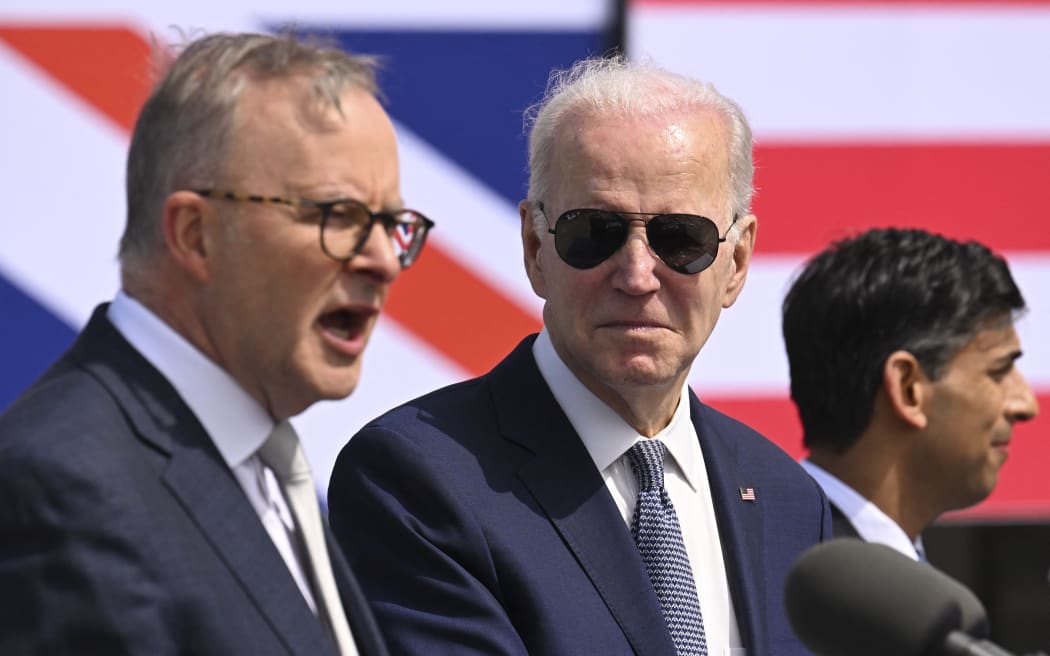
Anthony Albanese with US President Joe Biden. Photo: AFP
Australia's government will prioritise long-range precision strike, domestic production of guided weapons, and diplomacy - key points of a review released today recommending the country's biggest defence shakeup since World War II.
The review said the United States was no longer the "unipolar leader of the Indo Pacific", intense competition between the US and China was defining the region, and that the major power competition had "potential for conflict".
The country's northern bases will become a focus to deter adversaries, and protect trade routes and communications, the review said.
Prime Minister Anthony Albanese called the review "the most significant work that's been done since the Second World War".
"It demonstrates a world where challenges to our national security are always evolving. We cannot fall back on old assumptions. We must build the strength in our security by seeking to shape the future rather than waiting for the future to shape us," he told reporters.
China is undertaking its largest buildup since World War II, was not transparent about its intentions, and was engaged in strategic competition in Australia's near neighbourhood, the review said.
A public version of the classified report released on Monday said Australia must "avoid the highest level of strategic risk we now face as a nation: the prospect of major conflict in the region".
The military threat to Australia does not require invasion in the "missile age", it said.
Australia would work more closely with the United States, including increased bilateral military planning and hosting more rotations of US forces, including submarines, it said.
Australia must also strengthen defence cooperation with Japan, India, Pacific and South East Asian nations, the review said.
Defence funding will increase over the next decade, but will stay steady over the next four years, with funding of A$19 billion for the review's recommendations, including A$7.8b diverted from cancelled projects.
Australia must be able to defend its territories and the immediate region, deter any adversary's attempt to project power through its northern approaches, and protect trade routes and communications, Defence Minister Richard Marles said in the government's response to the review.
The review found Australia's defence force was "not fit for purpose", he said.
"We aim to change the calculus so no potential aggressor can ever conclude that the benefits of conflict outweigh the risks," he said.
The AUKUS nuclear-powered submarine programme is a priority for Australia's deterrence capability, the review confirmed.
Long-range strike and guided weapons were also "fundamental to the Australian Defence Force's ability to hold an adversary at risk" the review said, adding that domestic production of these weapons would be established, and acquisition sped up.
Australia will upgrade its northern bases and ports immediately, and the review said the country must rectify fuel storage issues.
The government said it would explore using civil mineral and petroleum industry infrastructure in northern and central Australia.
It also called for the development of cyber and space defence capabilities.
Areas it said were critical included undersea warfare, including drones for surveillance and strike; enhanced targeting; long-range strike; maritime operations for sea denial and local sea control; air and missile defence; expeditionary theatre logistics; and northern bases for logistics support and deterrence.
Australia's area of military interest spans the northeast Indian Ocean, through maritime Southeast Asia into the Pacific, the review said.
The navy needs more smaller vessels with long-range strike weapons, with details decided after an independent analysis this year, the report said. The government confirmed its commitment to naval shipbuilding.
The review recommends long-range anti-ship missiles for Australia's F-35A and F/A-18F fighter jets, and the development of the Ghost Bat uncrewed aircraft with the United States.
It urged the government to explore an existing integrated air and missile defence system, which it could obtain faster.
The review outlined three phases to reshape defence capabilities, with immediate priorities over the next two years including fitting longer-range weapons on existing platforms, accelerating new capabilities from 2026-2030, and delivering a "future integrated force" from 2031.
- Reuters

